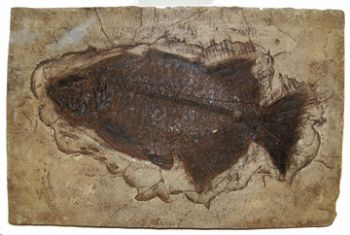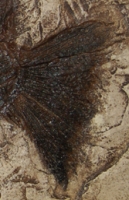
Spectacular Replica Fossil Fish
Phareodus belongs to the osteoglossids, which are represented today by the Arawana. Arawana are found in tropical and semitropical fresh waters of South America, central Africa, Southeast Asia, and northern Australia. Phareodus means: phare-to-hve, odus-tooth. Phareodus lived during the Eocene Epoch and is about 55 million years old They can be found in the fine grained limestone layers of the world famous Green River Formation. These fine grained layers of limestone contain very well preserved fossils of fish, insects, plants and other inhabitants of the area which allow us to get an extremely good view of the environment of these ancient fresh water lakes.
The Green River Formation was formed by a system of three fresh water lakes, which covered parts of Colorado. Utah, and Wyoming. The area covered by these lakes, named Fossil, Gosiute, & Uinta, covered about 25,000 square miles. The life span for these three lakes was over 17 million years for Lake Uinta about 6 million years for Lake Gosiute, and only about 2 million years for Fossil Lake. The average deposition thickness for these three takes is about 2000 feet. The deposition depth at the center of Fossil Lake is about 200-260 feet thick. Lake Uinta deposition is in excess of 7000 feet in places. The bulk of the fossil fish coming out of all three lakes is from Fossil Lake. Based on the types of flora and fauna found in the Green River Formation, it indicates that temperate to sub-tropical conditions existed, similar to the Gulf Coast of the United States today.
Phareodus was more common in Fossil Lake and rarely occurs in Lake Gosiute or Lake Uinta. As indicated by its name, Phareodus testis was a voracious predator. Spines from Mioplosus and Priscacara are frequently found in the stomachs of Phareodus, as further evidence.
Maximum size for Phareodus testis was about 15 inches. Body depth was about 43-52% of its length. The jaws of Phareodus testis are smaller with fewer teeth than Phareodus encaustus. The gill plate cover is slightly larger in P. testis. The pectoral fin ray is 20-30%, or more, of the body length (longer in adults). Scales of P. testis are larger and fewer than the scales of P. encaustus.
resin
17 x 11 inches
Item 144
Category: Replicas
Type: Skeletons
Phylum: Vertebrates
Class: Fish
MORE PHOTOS:



Now Over 1,000 Items!
PrehistoricStore.com offers the largest selection of replica fossils and other fossil-related products anywhere in the world!
Download a Full Catalog (3MB PDF)
OVER 260 PAGES OF REPLICAS AND MORE!
